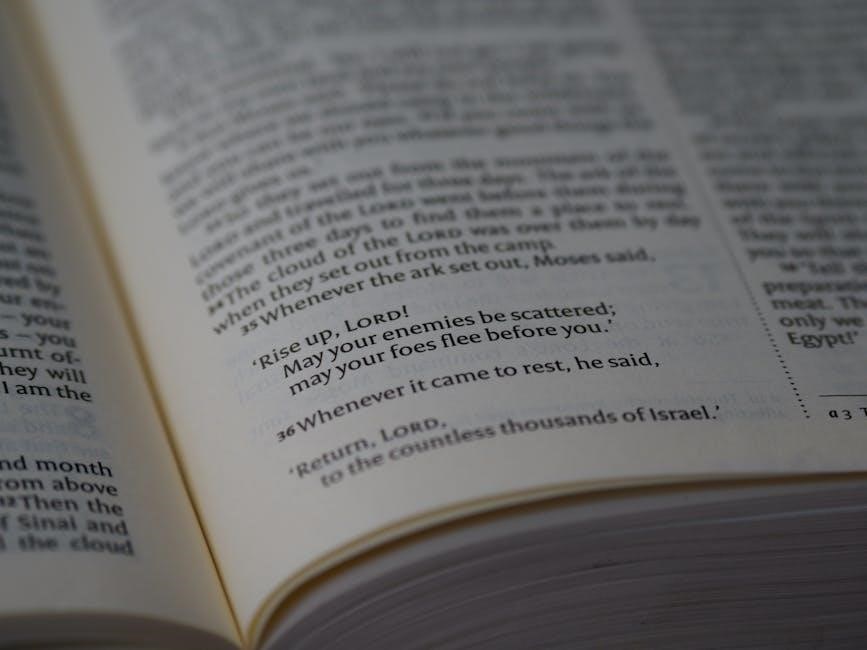The Bible, written over 1,500 years, spans from ancient times to around 90 AD, with 66 books by 40+ authors, transitioning from oral traditions to written texts.
1.1. Understanding the Significance of the Bible’s Timeline
The Bible’s timeline is crucial for comprehending its structure and historical context. Written over 1,500 years, it spans from ancient times to around 90 AD, with 66 books by 40+ authors. The Old Testament, written over 1,000 years, includes the Torah (circa 1400 BC) and later books like Malachi (432 BC); The New Testament, covering 50 years, begins with Jesus’ life and ends with Revelation (90 AD). The timeline reveals the gradual development of themes, cultural influences, and preservation efforts, offering insights into the Bible’s formation and enduring relevance as a unified message across diverse eras and writers.
1.2. Overview of the Bible’s Composition and History
The Bible’s composition spans over 1,500 years, with the Old Testament written between 1400 BC and 432 BC, and the New Testament completed by 90 AD. The earliest texts, like the Torah, were composed around 1400 BC, while later books, such as Malachi, were written near the end of the Old Testament period. The New Testament, written in Greek, covers the life of Jesus and the early Christian church. The Bible transitioned from oral traditions to written texts, with materials like papyrus and vellum used for recording; Scribes played a crucial role in preserving and transmitting the texts, ensuring their survival across centuries.

The Old Testament: Origins and Composition

The Old Testament, written over 1,000 years, began with the Torah around 1400 BC and concluded with Malachi by 432 BC, involving various authors and redactions.
2.1. The Earliest Texts: The Torah and Its Development
The Torah, the foundation of the Old Testament, consists of the first five books of the Bible, traditionally attributed to Moses. Scholars estimate its composition spanned from around 1400 BC to 600 BC, with the final redaction occurring during the Babylonian Exile in the 6th century BC. This period of development involved multiple authors and sources, blending oral traditions with written records. The Torah includes Genesis, Exodus, Leviticus, Numbers, and Deuteronomy, providing key narratives and laws that shaped Israel’s identity. Its formation reflects a gradual process of compilation, reflecting historical and cultural contexts of ancient Israel.
2.2. Historical Period Covered in the Old Testament
The Old Testament spans approximately 2,000 years, from Creation (c. 4000 BC) to the post-exilic period (c. 400 BC). It begins with the patriarchs (Abraham, Isaac, Jacob) and the Exodus from Egypt, followed by the conquest of Canaan and the period of Judges. The monarchy era includes the United Kingdom under Saul, David, and Solomon, and later the divided kingdoms of Israel and Judah. Key events like the construction of the Temple by Solomon and the Babylonian Exile (586 BC) are central. The post-exilic period covers the return to Jerusalem and the rebuilding of the Temple. Understanding this timeline provides insights into Israel’s history and the formation of its religious identity.
2.3. The Process of Canonization of the Hebrew Bible
The canonization of the Hebrew Bible occurred over centuries. The Torah was finalized during the Babylonian Exile (6th–5th centuries BC). By 400 BC, most prophetic and wisdom texts were included. The process concluded by 100 BC, with the Pharisees establishing the final canon at Jamnia (c. 90 AD). This ensured authoritative texts for Jewish communities, shaping their identity and religious practices. The canon’s closure marked a significant milestone in preserving Jewish scripture, influencing both Judaism and Christianity.

The New Testament: Historical Context and Development
The New Testament, written between 35-90 AD, includes the Gospels, Acts, Epistles, and Revelation. Composed decades after Jesus’ crucifixion, these texts reflect early Christianity’s growth and teachings.
3.1. The Life and Teachings of Jesus Christ
Jesus Christ’s life and teachings form the core of the New Testament. Born circa 4 BC, His ministry began around 28 AD, emphasizing love, forgiveness, and the Kingdom of God. The Gospels—Matthew, Mark, Luke, and John—detail His birth, miracles, parables, and resurrection. Written decades after His crucifixion (circa 30 AD), these accounts reflect early Christian beliefs. Jesus’ teachings, captured in sermons like the Sermon on the Mount, underscore moral principles and spiritual renewal. His death and resurrection are central to Christian theology, symbolizing redemption and eternal life. These events, though historically rooted, are presented as divine acts shaping human salvation.
3.2. The Period Between Christ’s Resurrection and the Writing of the Gospels
The time between Christ’s resurrection (circa 30 AD) and the composition of the Gospels (circa 70 AD) is crucial for understanding the development of the New Testament. During this period, Jesus’ teachings and life were preserved through oral tradition, shared among early Christian communities. The apostles, including Peter and Paul, played key roles in spreading His message. By around 50 AD, epistles like Galatians and 1 Thessalonians were written, while the Gospels were penned later, likely after the destruction of Jerusalem in 70 AD. This delay allowed for the refinement of narratives, ensuring the accurate transmission of Jesus’ life and teachings for future generations.
3.3. The Composition of the Epistles and Other New Testament Books
The epistles, or letters, of the New Testament were primarily written by Apostle Paul between 50-62 AD, with Galatians and 1 Thessalonians being the earliest. These letters addressed theological and practical issues in early churches. Other epistles, like Peter’s and James’, were composed later, around 63-100 AD. The Book of Revelation, written near 90 AD, concludes the New Testament. This period reflects the diversity of early Christian communities and the theological depth of their faith, providing foundational teachings that continue to guide believers today.

Challenges in Dating the Books of the Bible
Dating the Bible’s books is challenging due to the absence of explicit dates, requiring scholars to rely on stylistic, linguistic, archaeological, and textual analysis.
4.1. Lack of Explicit Dates in Biblical Texts
One of the primary challenges in dating the books of the Bible is the scarcity of explicit dates within the texts themselves. Few books provide clear chronological markers, forcing scholars to rely on indirect methods. Historical events, linguistic styles, and archaeological evidence often serve as the basis for estimation. For instance, the New Testament books are dated by correlating them with known historical events, such as the reign of Emperor Nero or the destruction of Jerusalem in 70 AD. The Old Testament presents similar difficulties, with scholars analyzing textual layers and historical correlations to determine composition dates. This lack of explicit dates complicates precise timelines, leading to ongoing scholarly debates and approximations.
4.2. Stylistic and Linguistic Analysis for Dating
Stylistic and linguistic analysis plays a crucial role in dating biblical texts. Scholars examine changes in language, vocabulary, and writing styles over time to estimate composition dates. For example, the New Testament books, written between 35 AD and 90 AD, show linguistic evolution, with earlier texts like 1 Thessalonians (circa 50 AD) differing from later works like Revelation. The Old Testament’s linguistic development, such as the transition from classical to late biblical Hebrew and the influence of Aramaic, helps scholars date texts like Isaiah and Daniel. The Septuagint, a Greek translation of the Old Testament (circa 250-200 BC), provides further linguistic clues, while the Dead Sea Scrolls reveal textual variations aiding in dating efforts.
4.3. Archaeological Evidence and Historical Correlations
Archaeological discoveries have significantly aided in dating biblical texts and correlating them with historical events. The Dead Sea Scrolls, for instance, include biblical texts from around 150 BC, such as parts of Daniel and Isaiah, confirming their antiquity. Historical records like the Babylonian Exile (6th century BC) and the Decree of Cyrus (538 BC) align with biblical narratives, providing a chronological framework. Excavations at sites like Jericho and Babylon have uncovered artifacts supporting biblical accounts. Additionally, the destruction of Jerusalem in 70 AD and the existence of cities like Capernaum and Nazareth validate New Testament contexts. These findings bridge the gap between biblical texts and historical realities, enhancing our understanding of the timeline.
4.4. Textual Analysis and Manuscript Tradition
Textual analysis and manuscript tradition play crucial roles in dating biblical texts. The Dead Sea Scrolls, including fragments like Isaiah and Daniel, date back to 150 BC, confirming the antiquity of parts of the Bible. Manuscripts like the Septuagint, a Greek translation of the Hebrew Bible, highlight textual evolution. Scribes meticulously copied manuscripts, ensuring consistency across generations. Early Christian communities used these texts, with New Testament books like Galatians and 1 Thessalonians written between 35 AD and 90 AD. Such traditions and analyses provide a reliable framework for understanding the Bible’s composition and transmission history, bridging ancient texts with modern scholarship.

Detailed Timeline Overview
The Bible’s timeline spans from creation (circa 4115 BC) to the New Testament era (around 90 AD), covering key events, compositions, and historical periods across Old and New Testaments.
5.1. Key Dates in the Old Testament Timeline
The Old Testament timeline begins with creation (circa 4115 BC) and spans to the close of the Hebrew Bible around 432 BC. Key dates include the birth of Seth (3985 BC), Enos (3880 BC), and the patriarchal era. The Exodus from Egypt is dated to 1445-1405 BC, with the conquest of Canaan following. The monarchy period (1020–586 BC) includes figures like Saul, David, and Solomon. The Babylonian Exile (586–538 BC) marks a significant turning point, with the restoration of Jerusalem occurring by 516 BC. The last book, Malachi, was written around 432 BC, closing the Old Testament era.
5.2. Major Events and Books of the Old Testament
The Old Testament recounts major events like creation (Genesis), the Exodus (Exodus), and the monarchy (1 Samuel, 2 Samuel, 1 Kings, 2 Kings). Key books include Job, Psalms, Proverbs, Ecclesiastes, and Song of Solomon. The prophets, such as Isaiah, Jeremiah, Ezekiel, Daniel, and the Minor Prophets, address judgment, restoration, and hope. Historical books like Joshua, Judges, and Ruth detail Israel’s conquest and early history. The Babylonian Exile and restoration are covered in books like Lamentations, Ezekiel, and Ezra-Nehemiah. These works collectively shape the theological and historical narrative of the Old Testament, spanning creation to the post-exilic period.
5.3. The Intertestamental Period
The Intertestamental Period, spanning approximately 400 years, bridges the Old and New Testaments. It began after the last book of the Old Testament (Malachi) was written around 432 BC and ended with the birth of Jesus Christ. Key events include the Babylonian Exile, the rebuilding of Jerusalem, and the rise of the Maccabees. This era saw the development of Jewish culture, the emergence of synagogue worship, and the influence of Greek and Roman rule. The period is crucial as it sets the stage for the arrival of Jesus, fulfilling prophetic expectations and paving the way for the New Testament narrative.
5.4. Key Dates in the New Testament Timeline
The New Testament timeline spans from the life of Jesus Christ to the writing of the Book of Revelation. Key dates include Jesus’ crucifixion and resurrection around 30 AD, the writing of Paul’s epistles between 49-62 AD, and the composition of the Gospels from 70 AD onward. The Book of Acts, detailing the early church, was written around 63 AD. The Epistles of Peter and Jude emerged in the late 1st century, while Revelation, the final book, was written circa 90 AD. These dates, though approximate, provide a framework for understanding the New Testament’s historical and literary development.
5.5. Major Events and Books of the New Testament
The New Testament chronicles the life of Jesus Christ, the establishment of the early church, and the spread of Christianity. Major events include the crucifixion and resurrection of Jesus (30 AD), the Pentecost and the birth of the church (Acts 2), and Paul’s missionary journeys (Acts 13-28). Key books include the Gospels (Matthew, Mark, Luke, John), which narrate Jesus’ life, and the Epistles of Paul, addressing early Christian communities. The Book of Revelation concludes the New Testament with apocalyptic visions. These events and writings form the foundation of Christian theology and practice, shaping the faith’s development and global influence.

The Process of Writing and Preserving the Bible
The Bible transitioned from oral traditions to written texts, with scribes meticulously copying manuscripts on materials like parchment and papyrus, ensuring preservation for centuries.
6.1. From Oral Tradition to Written Text
The Bible’s composition began with oral traditions, where stories, laws, and prophecies were passed down through generations before being written. Early texts like the Torah emerged around 1500-1400 BC, while the New Testament concluded by 90 AD. This gradual transition from spoken word to written form ensured preservation and unity of message. Scribes meticulously recorded these narratives on materials such as papyrus and parchment, laying the foundation for the Scriptures. This process spanned centuries, reflecting the evolution of language and culture while maintaining the core spiritual and historical essence of the texts.
6.2. The Role of Scribes in Preserving Scripture
Scribes played a pivotal role in preserving the Bible by meticulously copying and transmitting texts across generations. They ensured accuracy through precise replication, often memorizing and reciting passages before writing them down. Scribes used materials like papyrus and parchment, employing reeds or styluses for writing. Their work was essential during periods like the Babylonian Exile, when many texts were compiled and preserved. Over time, scribes also contributed to the standardization of Scripture, ensuring its survival and integrity. Their dedication laid the foundation for the Bible’s enduring presence, making them indispensable to its historical and spiritual legacy.
6.3. The Materials and Methods of Ancient Writing
Ancient writing relied on materials like papyrus, parchment, and vellum, often prepared from animal skins. Scribes used reed pens or styluses dipped in soot-based inks to write on scrolls or codices. Papyrus, made from plant fibers, was common in earlier periods, while parchment became prevalent later. The transition from scrolls to codices (book-like formats) improved accessibility and durability. These methods ensured the Bible’s texts were preserved accurately across centuries, with scribes meticulously copying manuscripts by hand. The materials and techniques evolved over time, adapting to technological advancements while maintaining the integrity of the sacred writings.

The Canonization of the Bible
The Bible’s canonization occurred over centuries, with the Hebrew Bible finalized by 100 CE and the New Testament canonized by the 4th century through church councils like Nicaea and Trent.
7.1. The Formation of the Old Testament Canon
The Old Testament canon, or Hebrew Bible, was formed over centuries, concluding around 100 CE. Its earliest texts, like the Torah, were written between 1200-400 BCE. The process involved scribes and scholars compiling sacred writings, with the Council of Jamnia in 90-100 CE finalizing the canon. This included 39 books divided into Law, Prophets, and Writings, excluding deutero-canonical books. The canon reflects Jewish religious and cultural identity, shaping the textual foundation for both Judaism and Christianity.
7.2. The Formation of the New Testament Canon
The New Testament canon was finalized by 397 AD, though its development began in the 1st century. Early councils, like Nicaea (325 AD) and Hippo (393 AD), played crucial roles. The Edict of Milan (313 AD) allowed open discussion, influencing the inclusion of 27 books. Widespread acceptance followed Carthage’s confirmation in 397 AD, solidifying the New Testament’s structure.
7.3. The Significance of Canonization in Biblical History
Canonization established a unified set of texts, ensuring consistency and authority across early Christian communities; It preserved theological unity, distinguishing sacred writings from others. The process validated the Bible’s role as a central religious text, shaping its influence on art, literature, and Western culture. Canonization also ensured the preservation of key teachings, maintaining religious identity and practice. This formalization of Scripture solidified its enduring relevance, providing a foundational guide for faith and ethics. The canon’s establishment marked a pivotal moment in Biblical history, cementing its authority and ensuring its legacy for future generations.

The Bible’s Historical and Cultural Impact
The Bible profoundly shaped literature, art, and Western civilization, inspiring countless works and influencing moral frameworks. Its teachings remain central to modern cultural and ethical discourse.
8.1. The Bible’s Influence on Literature and Art
The Bible has profoundly shaped literature and art, inspiring timeless works. Phrases like “an eye for an eye” and “love thy neighbor” are embedded in language and culture. Authors like Shakespeare and Dante drew heavily from biblical themes, while artists such as Michelangelo and Raphael depicted biblical scenes in iconic masterpieces. The Bible’s narratives, from creation to redemption, have influenced literature, poetry, and visual arts for centuries, making it a cornerstone of creative expression.
8.2. The Bible’s Role in Shaping Western Civilization
The Bible has profoundly shaped Western civilization, influencing law, ethics, education, and culture. Its principles formed the foundation of judicial systems, emphasizing justice and morality. Many universities, originally established to study theology, trace their roots to biblical scholarship. The Bible’s teachings on compassion and equality inspired movements for social justice, including abolition and civil rights. Its narratives and values have shaped Western literature, art, and philosophy, making it a cornerstone of cultural identity. The Bible’s impact on societal structures and individual consciousness remains unparalleled, underscoring its enduring role in shaping the West’s moral and intellectual landscape.
8.3. The Bible’s Enduring Relevance in Modern Times
The Bible remains a cornerstone of modern life, influencing literature, art, and culture. Its teachings continue to shape moral values, offering guidance on ethics and compassion. Despite changing times, its themes of love, justice, and redemption resonate deeply. The Bible’s stories and parables inspire films, music, and literature, ensuring its presence in popular culture. It also serves as a source of comfort and wisdom for millions, addressing universal human struggles. Its relevance extends beyond religion, impacting social justice movements and personal reflection. In a rapidly evolving world, the Bible’s timeless messages continue to inspire and influence individuals across generations.
The Bible, written over 1,500 years, is a testament to human faith and history. Its completion marks the end of a profound journey, preserving timeless wisdom and cultural heritage. Reflecting on its timeline reveals its enduring influence, shaping civilizations and inspiring generations. This conclusion invites deeper exploration into its rich history and continued relevance in modern times.
9.1. Summarizing the Timeline of the Bible’s Composition
The Bible’s composition spans over 1,500 years, with the Old Testament written between 1400 BC and 400 BC, and the New Testament between 35 AD and 90 AD. The Torah, the earliest texts, were composed around 1400 BC, while the New Testament began with the Gospels post-Jesus’ death. The intertestamental period, spanning 400 years, bridges the two testaments. The Bible’s timeline reflects a gradual transition from oral traditions to written texts, with scribes and scholars preserving and canonizing the scriptures over centuries. This timeline underscores the historical and cultural significance of the Bible’s development, highlighting its enduring relevance today.
9.2. The Significance of Understanding the Bible’s Timeline
Understanding the Bible’s timeline is crucial for grasping its historical context, theological themes, and cultural impact. It reveals the gradual process of composition over 1,500 years, from ancient oral traditions to written texts. This timeline highlights the transition from the Old Testament’s origins to the New Testament’s fulfillment in Christ. It also underscores the Bible’s influence on literature, art, and Western civilization. By studying the timeline, readers gain insights into the lives of authors, historical events, and the unity of Scripture. This knowledge enriches biblical study, providing a deeper appreciation for the Bible’s enduring relevance in modern times.
9.3. Encouragement for Further Study and Exploration

Exploring the timeline of the Bible offers profound insights into its historical and spiritual significance. Readers are encouraged to delve deeper into the lives of its authors, the cultural contexts, and the theological themes. Utilizing resources like detailed timelines, study guides, and scholarly articles can enhance understanding. Engaging with the Bible’s timeline fosters a richer appreciation of its message and relevance. It also invites reflection on how ancient texts continue to influence modern life. By pursuing further study, individuals can uncover the depth and unity of Scripture, gaining a lifelong treasure of wisdom and inspiration for personal growth and community discussion.
